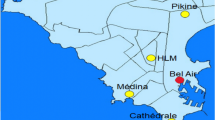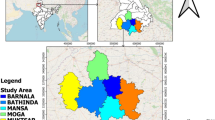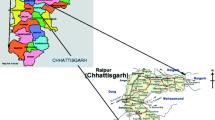Abstract
The high Himalayas in northern India are an essential source of climate generation and maintenance over the entire northern belt of the Indian subcontinent. It also affects extreme weather phenomena such as western disturbances in the region during winter. The work presented here describes the trends in 117-year precipitation changes and their impact on the western Himalayas and suggests some possible explanations in the context of changing rainfall patterns. Under the investigation, the forecasting efficiency and the prediction pattern of artificial neural network (ANN) and seasonal autoregressive integrated moving average (SARIMA) models for rainfall series in the western Himalayan states of India have been assessed. The results revealed significant changes in the monthly, seasonal, and annual rainfall series data for the three states of the Western Himalayan regions from the years 1900 to 2017. The study also concludes that the nonlinear autoregressive neural network (NARNN) models can be used to forecast the western Himalayan region data series well. According to the result interpretation, the highest rainfall may be estimated in August, 1632.63 mm (2023), whereas the lowest rainfall can be obtained in October (0.43 mm) during 2023. The model predicted a gradual decrease in annual rainfall trends in Uttarakhand and Himachal Pradesh from 2018 to 2023 despite heavy rainfall prediction in the monsoon season, whereas Jammu and Kashmir increase in annual rainfall has been predicted from 2018 to 2023. Possible explanations for the change in precipitation over the western Himalayas have also been proposed and explained.









Similar content being viewed by others
Data availability
Availability of data and material rainfall series was collected from Open Government Data (OGD) Platform India (www.data.gov.in).
Code availability
The code will be made available if asked for.
References
Adedeji PA, Akinlabi S, Ajayi O, Madushele N (2019) Non-linear autoregressive neural network (NARNET) with SSA filtering for a university energy consumption forecast. Procedia Manuf 33:176–183. https://doi.org/10.1016/j.promfg.2019.04.022
Akaike H (1974) A new look at the statistical model identification. IEEE Trans Autom Control 19(6):716–723. https://doi.org/10.1109/TAC.1974.1100705
Alwakeel M, Shaaban Z (2010) Face recognition based on haar Wavelet transform and principal component analysis via Levenberg-Marquardt back propagation neural network. Eur J Sci Res 42(1):25–31
Ali S, Shahbaz M (2020) Streamflow forecasting by modeling the rainfall–streamflow relationship using artificial neural networks. Model Earth Syst Environ 6:1645–1656. https://doi.org/10.1007/s40808-020-00780-3
Basistha A, Arya DS, Goel NK (2009) Analysis of historical changes in rainfall in the Indian Himalayas. Int J Climatol 29(4):555–572. https://doi.org/10.1002/joc.1706
Basistha A, Arya DS, Goel NK (2008) Spatial distribution of rainfall in Indian Himalayas–a case study of Uttarakhand region. Water Resour Manage 22(10):1325–1346. https://doi.org/10.1007/s11269-007-9228-2
Batool N, Shah SA, Dar SN, Skinder S (2019) Rainfall variability and dynamics of cropping pattern in Kashmir Himalayas: a case study of climate change and agriculture. Appl Sci 1(6):1–9. https://doi.org/10.1007/s42452-019-0599-9
Bhutiyani MR, Kale VS, Pawar NJ (2010) Climate change and the precipitation variations in the northwestern Himalaya. 1866–2006. Int J Climatol 30:535–548. https://doi.org/10.1002/joc.1920
Box GE, Jenkins GM, Reinsel GC, Ljung GM (2015) Time series analysis: forecasting and control. John Wiley & Sons
Cao Q, Ewing BT, Thompson MA (2012) Forecasting wind speed with recurrent neural networks. Eur J Oper Res 221(1):148–154
Chakraborty A, Joshi PK, Ghosh A, Areendran G (2013) Assessing biome boundary shifts under climate change scenarios in India. Ecol Indic 34:536–547. https://doi.org/10.1016/j.ecolind.2013.06.013
Chattopadhyay S, Chattopadhyay G (2010) Univariate modelling of summer-monsoon rainfall time series: comparison between ARIMA and ARNN. CR Geosci 342(2):100–107. https://doi.org/10.1016/j.crte.2009.10.016
Dabral PP, Murry MZ (2017) Modelling and forecasting of rainfall time series using SARIMA. Environ Process 4(2):399–419. https://doi.org/10.1007/s40710-017-0226-y
Dad JM, Muslim M, Rashid I, Rashid I, Reshi ZA (2021) Time series analysis of climate variability and trends in Kashmir Himalaya. Ecol Ind 126:107690. https://doi.org/10.1016/j.ecolind.2021.107690
Dada EG, Yakubu HJ, Oyewola DO (2021) artificial neural network models for rainfall prediction. Eur J Elect Eng Computer Sci 5(2):30–35. https://doi.org/10.24018/ejece.2021.5.2.313
Dash SK, Kulkarni MA, Mohanty UC, Prasad K (2009) Changes in the characteristics of rain events in India. J Geophys Res Atmos 114(D10109):1–12. https://doi.org/10.1029/2008JD010572
Desai VP, Kamat RK, Oza KS (2022) Rainfall modelling and prediction using neural networks: a case study of Maharashtra. Disaster Adv 15(3):39–43
Dickey DA, Fuller WA (1979) Distribution of the estimators for autoregressive time series with a unit root. J Am Stat Assoc 74(366a):427–431. https://doi.org/10.2307/2286348
Ghashghaie M, Eslami H, Ostad-Ali-Askari K (2022) Applications of time series analysis to investigate components of Madiyan-roodriver water quality. Appl Water Sci 12:202. https://doi.org/10.1007/s13201-022-01693-5
Giri RK, Loe BR, Singh R, Bali S (2008) Precipitation variability and its trend analysis over Kashmir region. Mausam 59(2):239–242
Guen, VL, and Thome N (2019) Shape and time distortion loss for training deep time series forecasting models. NeurIPS-2019. https://doi.org/10.48550/arXiv.1909.09020
Guhathakurta P, Rajeevan M (2008) Trends in the rainfall pattern over India. Int J Climatol: J Royal Meteorol Soc 28:1453–1469. https://doi.org/10.1002/joc.1640
Gurung B, Sarkar KP, Singh KN, Lama A (2021) Modelling annual maximum temperature of India: a distributional approach. Theor Appl Climatol 145:979–988. https://doi.org/10.1007/s00704-021-03674-1
Hagan MT, Menhaj MB (1994) Training feedforward networks with the Marquardt algorithm. IEEE Trans Neural Networks 5(6):989–993
Haydari Z, Kavehnia F, Askari M, Ganbariyan M (2007) Time-series load modelling and load forecasting using neuro-fuzzy techniques. In 2007 9th International Conference on Electrical Power Quality and Utilisation, IEEE 1–6
Holger RM, Dandy GC (2000) Neural networks for the prediction and forecasting of water resource variables: a review of modeling issues and applications. Environ Model Software 15(1):101–124. https://doi.org/10.1016/S1364-8152(99)00007-9
Ibrahim M, Jemei S, Wimmer G, Hissel D (2016) Nonlinear autoregressive neural network in an energy management strategy for battery/ultra-capacitor hybrid electrical vehicles. Electric Power Systems Research 136:262–269
Joshi JC, Kaur P, Kumar B (2020) HIM-STRAT: a neural network-based model for snow cover simulation and avalanche hazard prediction over North-West Himalaya. Nat Hazards 103(1):1239–1260. https://doi.org/10.1007/s11069-020-04032-6
Joshi R (2016) Artificial neural network (ANN)-based empirical interpolation of precipitation. Int J Math Eng Manag Sciences 1(3):93–106
Joshi S, Kumar K, Joshi V et al (2014) Rainfall variability and indices of extreme rainfall-analysis and perception study for two stations over Central Himalaya India. Nat Hazards 72(2):361–374. https://doi.org/10.1007/s11069-013-1012-4
Karthick SM, Arumugam P (2017) Stochastic modelling-based monthly rainfall prediction using seasonal artificial neural networks ICTACT. J. Soft Comput 1(2). https://doi.org/10.21917/ijsc.2017.0196
Kripalani H, Kulkarni A, Sabade SS (2003) Western Himalayan snow cover and Indian monsoon rainfall: a re-examination with INSAT and NCEP/NCAR data. Theor Appl Climatol 74(1):1–18. https://doi.org/10.1007/s00704-002-0699-z
Kulkarni GE, Muley AA, Deshmukh NK, Bhalchandra PU (2018) Autoregressive integrated moving average time series model for forecasting air pollution in Nanded City, Maharashtra India. Model Earth Syst Environ 4(4):1435–1444. https://doi.org/10.1007/s40808-018-0493-2
Kulkarni A, Patwardhan S, Kumar KK, Ashok K, Krishnan R (2013) Projected climate change in the Hindu Kush-Himalayan region by using the high-resolution regional climate model PRECIS. Mt Res Dev 33(2):142–151. https://doi.org/10.1659/MRD-JOURNAL-D-11-00131.1
Kumar V, Jain SK (2010) Trends in seasonal and annual rainfall and rainy days in Kashmir Valley in the last century. Quat Int 212(1):64–69. https://doi.org/10.1016/j.quaint.2009.08.006
Kumar PS, Praveen TV, Prasad MA (2016) Artificial neural network model for rainfall-runoff—a case study. Int J Hybrid Information Technol 9(3):263–272. https://doi.org/10.14257/ijhit.2016.9.3.24
Kwiatkowski D, Phillips PCB, Schmidt P, Shin Y (1992) Testing the null hypothesis of stationarity against the alternative of a unit root: how sure are we that economic time series have a unit root? J Econom 54(1–3):159–178
Lama A, Singh KN, Singh H, Shekhawat R, Mishra P, Gurung B (2022) Forecasting monthly rainfall of SubHimalayan region of India using parametric and non-parametric modelling approaches. Model Earth Syst Environ 8(1):837–845. https://doi.org/10.1007/s40808-021-01124-5
Li H, Haugen JE, Xu CY (2018) Precipitation pattern in the Western Himalayas revealed by four datasets. Hydrol Earth Syst Sci 22(10):5097–5110. https://doi.org/10.5194/hess-22-5097-2018
López M, Valero S, Senabre C, Aparicio J, Gabaldon A (2012) Application of SOM neural networks to short-term load forecasting: the Spanish electricity market case study. Electr Power Syst Res 91:18–27. https://doi.org/10.1016/j.epsr.2012.04.009
Madhura RK, Krishnan R, Revadekar JV, Majumdar M, Goswami BN (2015) Changes in western disturbances over the Western Himalayas in a warming environment. ClimDyn 44(3):1157–1168. https://doi.org/10.1007/s00382-014-2166-9
Malik A, Kumar A (2020) Spatio-temporal trend analysis of rainfall using parametric and non-parametric tests: case study in Uttarakhand India. Theor Appl Climatol 140(1):183–207. https://doi.org/10.1007/s00704-019-03080-8
Namasudra S, Dhamodharavadhani S, Rathipriya R (2021) Nonlinear neural network-based forecasting model for predicting COVID-19 cases. Neural Process Lett 1-21.https://doi.org/10.1007/s11063-021-10495-w
Manish K, Pandit MK (2018) Geophysical upheavals and evolutionary diversification of plant species in the Himalaya. Biodiversity Conserv PeerJ 6:e5919. https://doi.org/10.7717/peerj.5919
Naoya M (2001) Prediction of precipitation by a neural network method. J Nat Dis Sci 23(1):23–33
Martin T, Hagan HB, Demuth MH, Beale, De Jesus O (1996) Neural network design, vol 20. PWS Publishing Company, Boston
Mishra P, Alakkari KM, Lama A, Ray S, Shing M et al (2022) Modeling and forecasting of sugarcane production in South Asian countries. Curr Appl Sci Technol 23(1):1–15
Mishra P, Fatih C, Rawat D, Sahu S, Pandey SA, Ray M, Dubey A, Sanusi OM (2020a) Trajectory of COVID-19 data in India: investigation and project using artificial neural network, fuzzy time series and ARIMA models. Annu Res Rev Biol 35(9):46–54
Mishra P, Al Khatib AMG, Sardar I, Mohammed J, Ray M, Kumar M, Rawat D, Pandey SA, Dubey A, Feys J, Rono K (2020b) Modelling and forecasting of COVID-19 in India. J Infect Dis Epidemiol 6:162. https://doi.org/10.23937/2474-3658/1510162
Mislan H, Hardwinarto S, Sumaryono, Aipassa M (2015) Rainfall monthly prediction based on artificial neural network: a case study in Tenggarong Station, East Kalimantan—Indonesia. Procedia Computer Sci 59:142–151. https://doi.org/10.1016/j.procs.2015.07.528
Mohammadpour R, Asaie Z, Shojaeian MR et al (2018) A hybrid of ANN and CLA to predict rainfall. Arab J Geosci 11:533. https://doi.org/10.1007/s12517-018-3804-z
Mondal PP, Zhang Y (2018) Research progress on changes in land use and land cover in the Western Himalayas (India) and effects on ecosystem services. Sustainability 10(12):4504. https://doi.org/10.3390/su10124504
Mukherjee S, Joshi R, Prasad RC, Subhash CR, Vishwakarma KK (2015) Summer monsoon rainfall trends in the Indian Himalayan region. Theor Appl Climatol 121(3):789–802. https://doi.org/10.1007/s00704-014-1273-1
Murthy KVN, Saravana R, Vijaya K (2018) Modeling and forecasting rainfall patterns of southwest monsoons in North-East India as a SARIMA process. Meteorol Atmos Phys 130:99–106
Nandakumar SD, Valarmathi R, Juliet PS, Brindha G (2021) Artificial neural network for rainfall analysis using deep learning techniques. J Phys: Conf Ser 1964:042022. https://doi.org/10.1088/1742-6596/1964/4/042022
Narayanan P, Basistha B, Sarkar S, Kamna S (2013) Trend analysis and ARIMA modelling of pre-monsoon rainfall data for western India. CR Geosci 345(1):22–27. https://doi.org/10.1016/j.crte.2012.12.001
Nwokike CC, Offorha BC, Obubu M, Ugoala CB, Ukomah HI (2020) Comparing SANN and SARIMA for forecasting frequency of monthly rainfall in Umuahia. Scientific African 10(e00621):2468–2276. https://doi.org/10.1016/j.sciaf.2020.e00621
Nyanteh YD, Srivastava SK, Edrington CS, Cartes DA (2013) Application of artificial intelligence to stator winding fault diagnosis in permanent magnet synchronous machines. Electr Power Syst Res 103:201–213
Ouma YO, Cheruyot R, Wachera AN (2022) Rainfall and runoff time-series trend analysis using LSTM recurrent neural network and wavelet neural network with satellite-based meteorological data: case study of Nzoia hydrologic basin. Complex Intell Syst 8:213–236. https://doi.org/10.1007/s40747-021-00365-2
Padma S, Sanjeevi S (2014) Jeffries Matusita-based mixed measure for improved spectral matching in hyperspectral image analysis. Int J Appl Earth Obs Geoinf 32:138–151
Pal S, Mazumdar D (2019) Forecasting monthly rainfall using artificial neural network. RASHI 3(2):65–72
Panapakidis IP, Dagoumas AS (2016) Day-ahead electricity price forecasting via the application of artificial neural network-based models. Appl Energy 172:132–151
Patowary A, Pathak B, Hazarika J (2017) Studying monthly rainfall over Dibrugarh, Assam: use of SARIMA approach. Mausam 68:349–356
Perron P (1990) Testing for a unit root in a time series with a changing mean. J Bus Econ Stat 8(2):153–162
Praveen B, Talukdar S, Shahfahad MS, Mondal J, Sharma P, Toufiqul Islam ARM, Rahman A (2020) Analyzing trend and forecasting of rainfall changes in India using non-parametrical and machine learning approaches. Sci Rep 10:10342. https://doi.org/10.1038/s41598-020-67228-7
Punyapornwithaya V, Mishra P, Sansamur C, Pfeiffer D, Arjkumpa O, Prakotcheo R, Jampachaisri K (2022) Time-series analysis for the number of foot and mouth disease outbreak episodes in cattle farms in Thailand using data from 2010–2020. Viruses 14(7):1376:1–14. https://doi.org/10.3390/v14071367
Raghav YS, Mishra P, Alakkari KM, Singh M, Al Khatib AMG, Balloo R (2022) Modelling and forecasting of pulses production in South Asian countries and its role in nutritional security. Legum Res 45(4):454–461. https://doi.org/10.18805/LRF-645
Rahman UH, Ray S, Al Khatib AMG, Lal P, Mishra P, Fatih C, Williams AJ, Karakaya K, Shrivastri S, Alakkari K (2022) State of art of SARIMA model in second wave on COVID-19 in India. Int J Agric Statist Sci 18(1):141–152 (https://connectjournals.com/03899.2022.18.141)
Rajendra P, Murthy KVN, Subbarao A (2019) Use of ANN models in the prediction of meteorological data. Model Earth Syst Environ 5:1051–1058. https://doi.org/10.1007/s40808-019-00590-2
Rawat D, Sati SP, Khanduri VP, Riyal M, Mishra G (2021) Carbon sequestration potential of different land use sectors of western Himalaya. Advances in Carbon Capture and Utilization. Pant D, Nadda AK, Pant KK, Agarwal AK (Eds.) Springer Singapore. eBook ISBN 978–981–16–0638–0
Ray M, Sahoo KC, Abotaleb M, Ray S, Sahu PK, Mishra P, Al Khatib AMG, Das SS, Jain V, Balloo R (2022) Modeling and forecasting meteorological factors using BATS and TBATS models for the Keonjhar district of Orissa. Mausam 73(3):555–564. https://doi.org/10.54302/mausam.v73i3.1480
Ray S, Das SS, Mishra P, Al Khatib AMG (2021) Time series SARIMA modelling and forecasting of monthly rainfall and temperature in the South Asian countries. Earth Syst Environ 5:531–546. https://doi.org/10.1007/s41748-021-00205-w
Ray S, Bhattacharyya B (2020) Statistical modelling and forecasting of ARIMA and ARIMAX models for food grains production and net availability of India. J Expt Bio Agril Sci 8(3):296–309. https://doi.org/10.18006/2020.8(3).296.309
Ray S, Bhattacharyya B (2020b) Time series modeling and forecasting on pulses production behavior of India. Indian J Ecol 47(4):1140–1149
Ray S, Bhattacharyya B, Pal S (2016) Statistical modeling and forecasting of food grain in effects on public distribution system: an application of ARIMA model. Indian J Econ Dev 12(4):739–744
Romshoo SA, Bashir J, Rashid I (2020) Twenty-first century-end climate scenario of Jammu and Kashmir Himalaya, India, using ensemble climate models. Clim Change 162(3):1473–1491
Roy AB, Purohit R (2018) The Himalayas: evolution through collision. Indian Shield: Precambrian Evolution and Phanerozoic Reconstitution 311-327.https://doi.org/10.1016/B978-0-12-809839-4.00018-7
Sabin TP, Krishnan R, Vellore R, Priya P, Borgaonkar HP, Singh BB, Sagar S (2020) Climate change over the Himalayas. In: Krishnan R, Sanjay J, Gnanaseelan C, Mujumdar M, Kulkarni A, Chakraborty S (eds) assessment of climate change over the Indian region. Springer, Singapore. https://doi.org/10.1007/978-981-15-4327-2_11
Sati SP, Sharma S, Sundriyal YP, Rawat D, Riyal M (2020) Geo-environmental consequences of obstructing the Bhagirathi River, Uttarakhand Himalaya, India, geomatics. Nat Hazards Risk 11(1):887–905
Schwarz G (1978) Estimating the dimension of a model. Annals Statist. 6(2):461–464 (https://www.jstor.org/stable/2958889)
Shafiq MU, Rasool R, Ahmed P, Dimri AP (2019) Temperature and precipitation trends in Kashmir valley, North Western Himalayas. Theor Appl Climatol 135:293–304. https://doi.org/10.1007/s00704-018-2377-9
Shekhar MS, Rao NN, Paul S, Bhan SC, Singh GP, Singh A (2017) Winter precipitation climatology over Western Himalaya: altitude and range wise study. J Ind Geophys Union 21(2):148–152
Shekhar MS, Chand H, Kumar S, Srinivasan K, Ganju A (2010) Climate-change studies in the Western Himalaya. Ann Glaciol 51(54):105–112
Singh D, Jain SK, Gupta RD (2015) Trend in observed and projected maximum and minimum temperature over NW Himalayan basin. J Mount Sci 12(2):417–433
Singh P, Kumar N (1997) Effect of orography on precipitation in the western Himalayan region. J Hydrol 199:183–206
Singh RN, Sah S, Das B, Vishnoi L, Pathak H (2020) Spatio-temporal trends and variability of rainfall in Maharashtra, India: analysis of 118 years. Theor Appl Climatol 143:883–900. https://doi.org/10.1007/s00704-020-03452-5
Swain S, Nandi S, Patel, P (2018) Development of an ARIMA model for monthly rainfall forecasting over Khordha District, Odisha, India. In: Sa P, Bakshi S, Hatzilygeroudis I, Sahoo M (eds) recent findings in intelligent computing techniques. Advances in Intelligent Systems and Computing, 708. Springer, Singapore. https://doi.org/10.1007/978-981-10-8636-6_34
Taherdangkoo R, Tatomir A, Taherdangkoo M, Qiu P, Sauter M (2020) Nonlinear autoregressive neural networks to predict hydraulic fracturing fluid leakage into shallow groundwater. Water 12(3):841. https://doi.org/10.3390/w12030841
Tewari VP, Verma RK, von Gadow K (2017) Climate change effects in the Western Himalayan ecosystems of India: evidence and strategies. For Ecosyst 4(1):13. https://doi.org/10.1186/s40663-017-0100-4
Tran Anh D, Duc DT, Pham VS (2019) Improved rainfall prediction using combined pre-processing methods and feed-forward neural networks. J 2(1):65–83. https://doi.org/10.3390/j2010006
Upgupta S, Sharma J, Jayaraman M, Kumar V, Ravindranath NH (2015) Climate change impact and vulnerability assessment of forests in the Indian western Himalayan region: a case study of Himachal Pradesh, India. Climate Risk Manag 10:63–76
Unnikrishnan P, Jothiprakash V (2020) Hybrid SSA-ARIMA-ANN model for forecasting daily rainfall. Water Resour Manage 34:3609–3623. https://doi.org/10.1007/s11269-020-02638-w
Valipour M (2016) Optimization of neural networks for precipitation analysis in a humid region to detect drought and wet year alarms. Meteorol Appl 23:91–100. https://doi.org/10.1002/met.1533
Wang W, Du Y, Chau K, Chen H, Liu C, Ma QA (2021) Comparison of BPNN, GMDH, and ARIMA for monthly rainfall forecasting based on wavelet packet decomposition. Water 13:2871. https://doi.org/10.3390/w13202871
Wasson RJ, Sundriyal YP, Chaudhary S, Jaiswal MK, Morthekai P, Sati SP, Juyal N (2013) A 1000-year history of large floods in the Upper Ganga catchment, central Himalaya. India Quat Sci Rev 77:156–166
Yusof F, Kane IL (2012) Volatility modelling of rainfall time series. TheorApplClimatol 113:247–258. https://doi.org/10.1007/s00704-012-0778-8
Acknowledgements
Authors acknowledge Open Government Data (OGD) Platform India for data availability.
Author information
Authors and Affiliations
Contributions
Preparation of the original manuscript: DR and PM; data compilation: SR, HHFW, and SPS; coding and analysis: GM, HA, and MA; results and discussion: DR, PM, SR, and HHFW; finalization of the manuscript: DR, PM, and SR.
Corresponding author
Ethics declarations
Ethics approval and consent to participate
All authors consent to participate into the study.
Consent for publication
All authors consent to publish the study in a journal article.
Conflict of interest
The authors declare no competing interests.
Additional information
Responsible Editor: Zhihua Zhang
Rights and permissions
Springer Nature or its licensor (e.g. a society or other partner) holds exclusive rights to this article under a publishing agreement with the author(s) or other rightsholder(s); author self-archiving of the accepted manuscript version of this article is solely governed by the terms of such publishing agreement and applicable law.
About this article
Cite this article
Rawat, D., Mishra, P., Ray, S. et al. Modeling of rainfall time series using NAR and ARIMA model over western Himalaya, India. Arab J Geosci 15, 1696 (2022). https://doi.org/10.1007/s12517-022-10994-7
Received:
Accepted:
Published:
DOI: https://doi.org/10.1007/s12517-022-10994-7




